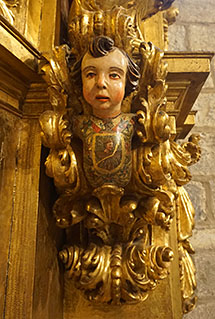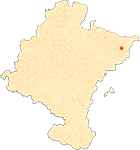Route through the Roncal altarpieces
By Ricardo Fernández Gracia
Introduction
he towns that make up the Roncal Valley have preserved a good issue of altarpieces that correspond to the centuries of the Modern Age, in the different styles that follow one another: Renaissance, Mannerism and Baroque. By the middle of the 16th century, the altarpieces had already become enormous machines that housed under their Structures, known by some Navarrese masters as "School of Architecture", cycles of painting and sculpture with themes chosen for the catechisation of the people, who were highly illiterate. The examples preserved in the Valley are a further testimony to how, during those centuries, the genre reached its greatest Degree plenitude, at a time when the means of disseminating culture were mainly oral and plastic.
All the 16th, 17th and 18th century altarpieces from Roncal were made of wood, generally pine, a particularly ductile material for carving and, above all, susceptible to receiving a layer of gold that turned them into veritable embers of light and golden scenographies. Moreover, the vibration of their forms, the density of their decoration and the multiplicity of their images gave the temples of the time, almost always with rigid, inert walls cut at right angles, a sensation of mobility and expansion of space which they lacked structurally. The altarpieces thus produced an illusionism that was very characteristic of the Baroque, in which the dichotomy between background and figure, between surface and reality, was only deceptively resolved.
With the colouring and gilding - an operation in which high-carat gold leaf was used - the altarpiece, illuminated by the dim light of the candles, glowed like an ember in the half-light of the temples, insinuating itself to the public eye like a celestial apparition. In this respect, we cannot fail to mention the eloquent Latin phrase that appears on the Isaba altarpiece next to the donors who made the polychromy and gilding of the piece possible: LUCERE FECERUNT.
The ensemble presented can be used to see the evolution of the altarpiece genre throughout the 16th, 17th and 18th centuries, from the early Renaissance casillero altarpiece with multiple iconography (Isaba), to more classicist examples (Uztárroz) and in a later stage where the rhetorical and scenographic triumphs, with the incorporation of moving designs and supports of Solomonic columns dressed in fashion (Zuberoa, Garde, Idoia, Salvador de Urzainqui and Castillo de Roncal) or eighteenth-century balusters (Urzainqui and sponsorship de Uztárroz).
Masters from Pamplona, Tudela, Sangüesa and nearby Aragonese towns, such as Sos or Uncastillo, and even from the valley itself are the authors of these sculptures, with the sculptors of the Pejón family in Garde, Roncal, Urzainqui and Burgui standing out, as well as those of local masters who had workshops in different localities, such as Manuel Gorri, Pascual de Lorea, Pedro José Urzainqui or Miguel Ayerdi and the gilder Joaquín Elizondo (or Joaquín Suescun de Elizondo), who left his goods to the church of Garde in his will (1721). The Aragonese influences are evident either through the arrival of the craftsmen or through the style of the works, which is logical if we take into account the geographical proximity and the fact that they belonged to the same diocese of Pamplona which, at that time, covered the archpriesthood of Valdonsella. With regard to the promoters and their financing, there are all kinds subject: private individuals, clerics, trustees, as well as those paid for by alms and even Indian wealth.
A rich heritage that speaks in a multidisciplinary way of history, aesthetics, patrons and promoters, artists, messages, iconography, use and function and techniques. The architecture, painting, sculpture and polychrome reliefs that make up the iconographic programme of an altarpiece demanded a wide repertoire of techniques applied to imitate fabrics, meats, various objects and varied textures, depending on the period and fashions, producing, as a whole, an illusionist effect that effectively enhances the miraculous character of the altar, while magnifying the dimensions of the temple.
Parish archives of Garde, Vidángoz, Isaba, Uztárroz and Roncal.
file Diocesan of Pamplona. Processes
file General of Navarre. Roncal Notary's Office and Processes
ARDANAZ IÑARGA, N., La catedral de Pamplona en el siglo de las Luces. Arte, ceremonial y cultura, Pamplona, doctoral dissertation sustained at the University of Navarre, 2011. Vid. http://hdl.handle.net/10171/20480
BOLOQUI LARRAYA, B., Escultura zaragozana en la época de los Ramírez 1710-1780, Madrid, Ministerio de Cultura, 1983.
CHOCARRO HUESA, M., "El obispo Juan Rena, mediador y mecenas artístico de la catedral de Pamplona", Príncipe de Viana, 256 (2012), Issue dedicated to: programs of study sobre el Patrimonio Cultural y las artes en Navarra en torno a tres hitos 1212-1512-1812, (coordinated by Ricardo Fernández Gracia), pp. 587-601.
CLAVERÍA ARANGUA, J., Iconografía y santuarios de la Virgen en Navarra, vol. I, Madrid, Gráfica management assistant, 1942.
ECHEVERRÍA GOÑI, P., Polychromy of the Renaissance in Navarre, Pamplona, Government of Navarre, 1990.
GARCÍA GAÍNZA, M. C., Romanesque sculpture in Navarre. Disciples and followers of Juan de Anchieta, Pamplona, 1969.
GARCÍA GAÍNZA, M. C. et alt., Catalog Monumental de Navarra, IV* y IV**. Merindad de Sangüesa, Pamplona, Government of Navarra - Archbishopric of Pamplona - University of Navarra, 1989 and 1992.
FERNÁNDEZ GRACIA, R., El retablo barroco en Navarra, Pamplona, Government of Navarre, 2003.
FERNÁNDEZ GRACIA, R., "Los géneros escultóricos", El arte del Barroco en Navarra, (coord. R. Fernández Gracia), Pamplona, Gobierno de Navarra, 2014, pp. 175-271.
GÁRRIZ, J., La villa de Garde en el Valle del Roncal. essay de una monografía parroquial, Pamplona, Casa publishing house de G. Huarte, 1923.
HUALDE, F., "De cuando los Ezquer cruzaron el charco", Diario de Noticias de Navarra, 18 August 2008. http://patrimonionavarra2.blogspot.com.es/2010/09/18-de-agosto-de-2008.html
MORALES SOLCHAGA, E., "El gremio de San José y Santo Tomás de Pamplona hasta el siglo XVII", Príncipe de Viana, no. 239 (2006), pp. 791-860.
URANGA, J. E., Retablos navarros del Renacimiento, Pamplona, Institución Príncipe de Viana, 1947.












